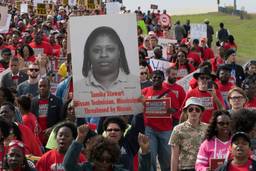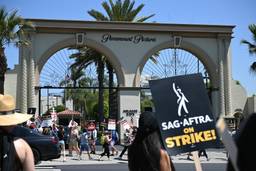The picture of the nation’s job market remained pretty much in a “holding pattern” in August, according to Center for American Progress economist Heather Boushey. Private jobs grew a little – less than in July, but that was more than offset by layoff of temporary federal census workers, and more people re-entered the search for work.
The statistical upshot: the official unemployment rate rose a tenth of a percent to 9.6 percent (16.7 percent if the underemployed, discouraged and marginally attached are included).
But the Labor Department Report “provides absolutely no support to the [commonly expressed conservative] view that firms are deferring hiring because of uncertainty about taxes and regulation, or that unemployment is increasingly structural in nature” (meaning that workers lack skills to fill job openings), according to Center for Economic and Policy Research co-director Dean Baker. There just aren’t enough jobs or demand for goods and services.
Even though private job growth continued for the eighth straight month, it was not fast enough even to absorb new entrants to the world of work. Not great news for workers, Not great news for the administration and Democrats running for office this fall.
President Obama highlighted the “positive news,” while saying “it’s not nearly good enough.” He urged the Senate to pass a House-approved aid bill for small business, pointing out that it would not increase the deficit. Next week the administration will unveil new proposals to stimulate job growth, most likely tax breaks offset elsewhere to be deficit neutral, but insiders insist it will not be a “second stimulus.” AFL-CIO president Trumka, who saw “little progress,” wants more (from spending on infrastructure to fairer trade, and most liberal economists and think tanks urge something equivalent to a second stimulus.
But new reports out this week make it clear that the recession has intensified pre-existing trends towards disproportionate creation of low-wage, low-skill jobs and to a big squeeze on the incomes of workers with jobs. The trends, along with slow job creation, act as a drag on economic recovery, but they are fattening the corporate cash boxes and CEO wallets.
UC Berkeley public policy professor Robert Reich and University of Chicago Booth School of Business finance professor Raghuram G. Rajan, both argue that the record high levels of inequality contributed to the crisis, as desperate families whose real incomes were slipping tried to live off credit, much of it backed by a housing bubble.
Now when people find jobs, they are disproportionately lower-paid than what they lost. MIT economist David Autor reports that “the Great Recession has reinforced these trends [already present towards polarization of job creation between high- and low-wage occupations] rather than reversing or redirecting them.”
The National Employment Law Project found that job losses in 2008-2009 hit across the board, including high-wage industries, but the jobs created in 2010 disproportionately pay less than $15 an hour: One-third of losses were in such jobs, but 76 percent of new jobs in 2010 paid under $15. (The two studies differ over how many middle- income jobs have been lost, possibly because Autor focuses on occupations, HELP on industries, but both paint a bleak picture).
Workers with jobs, old or new, have “suffered from a broad-based collapse of wage growth over the last two years,” according to a new report from the Economic Policy Institute, as pay continues to lag far behind productivity growth. The longer the recession drags on, the less the gain – or, in many cases, the greater the loss – of real wages across all income groups. In many industries, employers drove down employment far more than expected, held down or cut wages, shifted more health care costs to workers, and then as growth has picked up, employers have refused to hire, overworked their employees and pocketed the cash.
That process yields two results: According to the Economic Security Index, developed by political scientist Jacob Hacker and colleagues, “in 2009, the level of economic insecurity experienced by Americans was greater than at any time over the past quarter century, with approximately one in five Americans (20.4 percent) experiencing a decline in available household income of 25 percent or greater.”
And at the top? It’s party time. Researchers at the Institute for Policy Studies found that there’s little recession for the rich: real CEO pay for last year “is still running at double the 1990s CEO pay average, quadruple the 1980s average, and eight times the average executive pay in the mid-20th century.”
It’s even more lush for the 50 major corporations with the greatest number of layoffs since the crisis began – even though 72 percent of them were making a profit at the time. The average CEO of these job destrioyers took home $12 million, 42 percent more than the average S&P 500 chief executive.
There’s a lesson here. If we want to get out of this recession, put people back to work, sustain long-term growth, and reduce the severity of future business cycles (not to mention making this a better country), we have to drastically redistribute incomes and reduce inequality. Then we can begin tackling the hard stuff.

I hope you found this article important. Before you leave, I want to ask you to consider supporting our work with a donation. In These Times needs readers like you to help sustain our mission. We don’t depend on—or want—corporate advertising or deep-pocketed billionaires to fund our journalism. We’re supported by you, the reader, so we can focus on covering the issues that matter most to the progressive movement without fear or compromise.
Our work isn’t hidden behind a paywall because of people like you who support our journalism. We want to keep it that way. If you value the work we do and the movements we cover, please consider donating to In These Times.
David Moberg, a former senior editor of In These Times, was on staff with the magazine from when it began publishing in 1976 until his passing in July 2022. Before joining In These Times, he completed his work for a Ph.D. in anthropology at the University of Chicago and worked for Newsweek. He received fellowships from the John D. and Catherine T. MacArthur Foundation and the Nation Institute for research on the new global economy.







